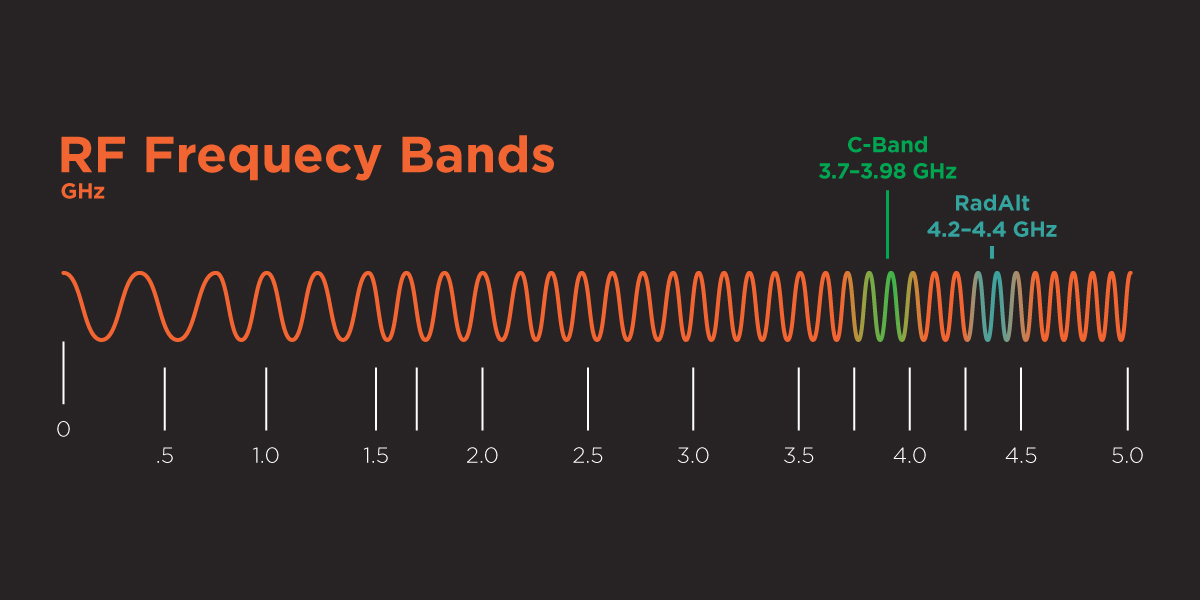Click Here to View This Page on Production Frontend
Click Here to Export Node Content
Click Here to View Printer-Friendly Version (Raw Backend)
Note: front-end display has links to styled print versions.
Content Node ID: 414528
Starting last January, US cellular telephone companies began using the C-Band 5G networks. These new 5G cellular emissions lie near the frequencies used by Radio Altimeters (also referred to as RADALT and Radar Altimeters) installed in many aircraft. Band leakage from these emissions could degrade performance of the RADALT and other dependent aircraft systems. 
In 2020, the Federal Communications Commission cleared additional wireless communications spectrum for 5G use by reallocating the spectrum between 3.7 and 3.98 GHz. This spectrum is near the 4.2-4.4 GHz band used by RADALT. If band boundaries were hard and fast, there would be no concern. However, some equipment in use today can experience band leakage and RADALTs could be susceptible to RF (Radio Frequency) interference received in the band of operation or within adjacent, nearby frequency bands.
Possible Issues
Potential issues are many, diverse, and complex. 5G interference could cause RADALT malfunctions that could produce unreliable results or failure to function, especially during take-off and landing maneuvers. For example, the aircraft navigation system could be prompted to warn the pilots of non-existing obstacles or even fail to warn them in time of the existence of real obstacles. RADALTs may also be integrated with other aviation equipment, including but not limited to TCAS (Traffic Collision Avoidance Systems), TAWS/EGPWS (Terrain Alert Warning Systems), Flight Director and Autopilot systems.
For years, the FAA, the aviation industry, telecommunications companies, and telecom regulators have been discussing and weighing concerns regarding aviation safety due to interference from the expansion of 5G C-Band usage. With all the noise surrounding this issue, many business aviation professionals have downplayed these messages. The time for business aircraft operators to better understand the situation and begin to plan for compliance with upcoming mandates is now.
FAA Rules
The FAA has issued ADs and NOTAMs prohibiting specific operations as well as Alternative Methods of Compliance (AMOCs), and telecommunications companies have scheduled controlled 5G rollouts around popular airports. On Dec 7, 2021, the FAA issued AD 2021-23-12 addressing operational limitations for low-visibility approaches and how they will be applied through NOTAM announcements. More recently, the FAA has acted to release a Notice of Proposed Rulemaking (NPRM) with proposed guidelines for all transport and commuter category airplanes equipped with RADALTs. NPRM 4910-13-P outlines proposed changes to allow for continued safe operation in the 5G frequency environments. Permanent solutions are in work by OEM manufacturers and will come in the form of signal filters, RADALT retrofits, re-designs, and more.
Duncan Aviation has compiled resources that discuss potential 5G interference and has put them in one place so operators can easily learn more. To help you better understand this important and dynamic issue, take a look at the Duncan Aviation 5G Be Prepared page, which Duncan Aviation will periodically update: https://duncanaviation.aero/services/avionics-installation/5G
Take the Survey
In addition to compiling topic data for operators to review, Duncan Aviation is gathering data about how operators plan to meet upcoming mandates. Participate in the survey here:
